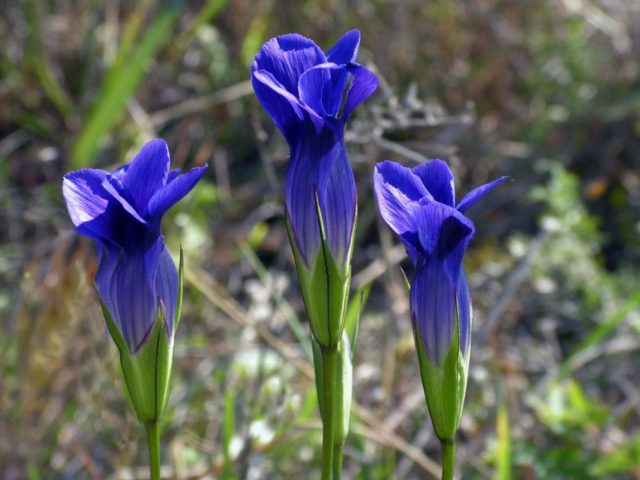Content
You can often find wild plants in garden plots, because they are particularly attractive, and with their help you can create original flower beds. Rough gentian is popular among gardeners. In addition to its original appearance, the plant has a number of healing properties and is widely used in folk medicine.

Gentian rough blooms until early autumn
Description of the species
This plant belongs to the Gentian family and is a herbaceous perennial. Judging by its external features, it immediately stands out among other species. The height of the stem reaches 30-45 cm, the leaves are paired, ovoid in shape with a pointed apex (their length is from 5 to 7 cm). The lower veins have a rough edge.
The flowers are colored deep blue and have a bell shape. The budding of the plant lasts until August. Gentian bears fruit in the form of a capsule with two valves, in which linear reticulate seeds are formed.
Where and how does rough gentian grow?
In its natural environment, this plant can be found in the Far East or the Southeast regions of Asia.Over time, gentian has significantly expanded its range: it grows almost everywhere, with the exception of the African continent and Antarctica.

The plant thrives in areas with rocky soil, so in gardens it can most often be seen in rockeries
Composition and value of the plant
The most beneficial substances in this plant are contained in the rhizome. Fresh roots contain bitter glycosides, which are beneficial for intestinal function. They also contain bioflavonoids (which are effective in preventing cancer and problems with the cardiovascular system), fatty oils, sucrose, pectin, mucus and alkaloids.

Gentian roots are a preventative against diabetes
Medicinal properties
The therapeutic properties of this plant have been known since ancient times. Today it is widely used in official medicine to treat various diseases. Most often, herbal mixtures and various preparations are used, which include gentian extracts. They are most effective in the treatment of inflammatory processes in the joints and malfunctions of the gastrointestinal tract.
Use in folk medicine
In folk medicine, decoctions of the roots are used to improve appetite, as a choleretic, hemostatic and anti-inflammatory agent. Gentian rough copes well with the healing of purulent wounds, eye diseases, cough, and gout.

Gentian rough helps with stomach disorders
In Korea and Japan, gentian-based preparations are used as an antipyretic and sorbent for food poisoning.This plant is no less useful for hypertension, cystitis, and skin diseases. The Chinese use infusions and decoctions from this plant to combat influenza, nephritis, rheumatism, and potency problems.
The healing properties of the plant also interested Tibetan healers. They use gentian for attacks of neurasthenia, problems with women's health, and bone tuberculosis. The Mongols give patients gentian remedies for fever, laryngitis and tracheitis.
A few simple recipes from the plant to combat various ailments:
- Constipation. An infusion that is prepared like this helps a lot: 50 g of dry roots are poured into ½ liter of vodka and infused for a week. Take 20 drops/100 ml of water (20 minutes before meals). You can also buy herbal infusions at the pharmacy, which have a mild laxative effect and are not addictive.
- Gastritis, which is caused by low acidity. For this, a multi-herbal collection is used, consisting of mint, string, gentian, saphora japonica, trefoil and flax seeds. All these components are mixed together in equal parts and placed in paper bags. To prepare the decoction, you need 1 tbsp. l. Add the collection to a glass of boiling water and hold in a water bath for about 10 minutes. Next, remove it from the heat and leave for another 45 minutes. Then filter through cheesecloth and drink 1/3 cup 30 minutes before meals. The course of treatment is 1 month.
- Rheumatism and arthritis. To prepare the decoction you will need 3 tbsp. l. gentian and 700 ml of water. The container is placed in a water bath for 15 minutes, and then left for the next 2 hours. The decoction is taken orally half a glass half an hour before meals. Compresses on the joints also give good results.They help relieve swelling, inflammation, reduce pain, and make joints more mobile.
Gentian flowers are also used to prepare decoctions. They help with pathologies of the mammary glands, amenorrhea, and hepatitis. Baths relieve excessive sweating of the feet and kill unpleasant odors. An infusion of gentian root or herbal tea can easily help solve the problem of constipation.
Restrictions and contraindications
Any medicinal plant can be both beneficial and harmful.
You should not use gentian rough in the following cases:
- Individual intolerance to any of the substances in the composition of gentian. This can lead to a severe allergic reaction.
- Arterial hypertension.
- Peptic ulcer (gentian increases acidity, which will lead to an exacerbation of the disease).
- During pregnancy and during lactation.

Decoctions and infusions of gentian rougha are not recommended for children
Conclusion
Gentian rough has a number of useful properties and allows you to cope with various ailments. With proper intake, you can establish metabolic processes, restore normal intestinal function, relieve inflammation and strengthen the body. You can purchase teas and infusions at any homeopathic pharmacy or prepare them yourself. To do this, you need to prepare raw materials in advance.
The most valuable are plants that have reached three years of age. Their rhizomes are dug up, washed, and then placed in special dryers (temperature from + 45 to + 60 °C). Before using gentian, you should consult an experienced homeopath or your doctor.








